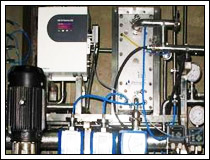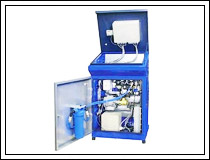Electro de-Ionization (EDI) Systems
 Electro de-Ionization (EDI) systems are high-tech tech machines that employ a popular chemical-free process of water purification called Electrodeionization. These machines operate on the phenomenon of ion exchange membranes and electricity, eliminating the need for tank exchange service. Electro de-Ionization (EDI) systems are high-tech tech machines that employ a popular chemical-free process of water purification called Electrodeionization. These machines operate on the phenomenon of ion exchange membranes and electricity, eliminating the need for tank exchange service.
Of late, Electrodeionization is gaining immense popularity as a water purifying technology due to its cost effectiveness and efficaciousness. This water treatment technique is actually a chemical-free process that removes ionized and ionizable species from solution using ion exchange resins that are continuously regenerated by an electric current. The water purified in the process is extremely pure and is generally referred to as type 2 water.
The Process
The EDI modules, also called stacks, are filled with mixed bed ion exchange resins that act to retain the ions forcing them to be transported across the ion exchange membranes. Between each anion and cation there exists three chambers of which the center compartment is called the dilute (product water) compartment and the two compartments on either end are termed the concentrating (waste) compartments. When a DC current is passed through the cell, the cations migrate from the diluting compartment through the cation permeable membrane towards the cathode, and the anions migrate towards the anode throughthe anion permeable membrane and both are removed in the concentrating streams. This blocks the cations from the left concentrate compartment from entering into the dilute stream towards the cathode by the selectively permeable anion  membrane. In a similar way, the anions in the right side concentrate compartment are blocked from passing into the dilute stream towards the anode by the selectively permeable cation membrane. The end result is deionized water passing through the dilute stream. membrane. In a similar way, the anions in the right side concentrate compartment are blocked from passing into the dilute stream towards the anode by the selectively permeable cation membrane. The end result is deionized water passing through the dilute stream.
EDI provides a high quality of water in the range of 10-15 MΩ× cm with typically < 30 ppb of TOC and controllable flow rates. This cost effective technology also eliminates the cost and labor involved with the regeneration of mixed bed resins which also necessitate the use of costly chemicals. But it has to be noted that Electrodeionization is not that effective at removing bacteria that require pretreatment steps.
|